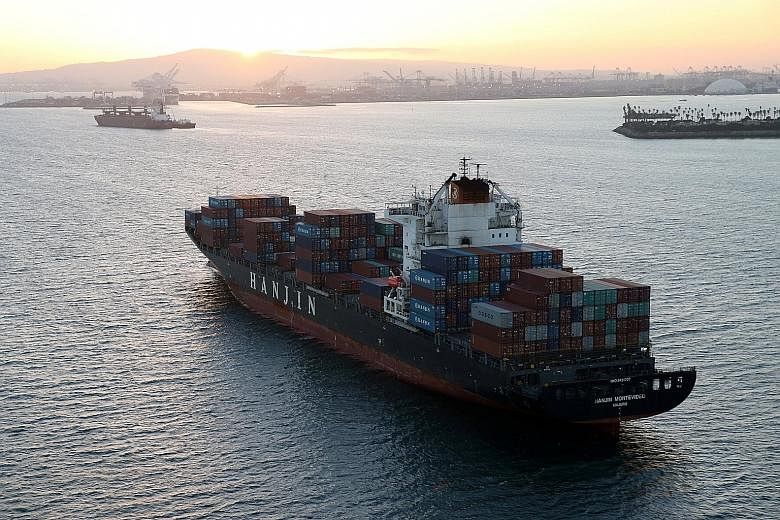For an industry that has seen no end of drama over the past six years or so, 2016 will go down as one of the stormiest 12 months on record.
And there is plenty of uncertainty surrounding global trade in 2017 as well, which could continue to weigh on Singapore, given its role as a maritime hub.
The turbulence has been coming from all directions this year, led by an unprecedented wave of mergers and acquisitions (M&As), which included the completion of French shipping giant CMA CGM's historic $3.38 billion buyout of Singapore's own Neptune Orient Lines (NOL).
But what really shook the market was the full-blown bankruptcy of South Korea's biggest shipping line, Hanjin Shipping Company - a catastrophe that triggered a massive disruption in global trade when the group filed for court receivership on Aug 31.
Other players have swiftly moved in to take up the routes left behind by Hanjin, once the world's seventh-largest shipping firm. The debt-laden company faces liquidation while a resolution of its debts, if achievable, could drag on for years.
Mr Andy Lane, partner at shipping consulting firm CTI Consultancy, sums it up: "We started the year with 17 independent global carriers, and through a sequence of M&As and a major bankruptcy, this number will shrink to 10 as integrations take place through 2018.

"The industry as a whole will generate an aggregate trading loss for the year. And still, 2016's radical transformations remain insufficient for long-term profitability and sustainability."
If 2016 is anything to go by, the year ahead could bring just as much uncertainty. Mr Lane adds: "Volatility might subside, now with fewer fingers on pricing buttons. But with a huge idle fleet, revenue levels are not going to skyrocket."
THE CONSOLIDATION WAVE
"Consolidation - I believe it is the name of the game in our industry," Mr Rodolphe Saade, vice-chairman of CMA CGM, the world's third-largest shipping line, told a conference in Copenhagen in October.
He added: "We have experienced some in the past few months... I am sure there will be more to come."
Indeed, CMA CGM's $3.38 billion acquisition of NOL - the first amid the ongoing downturn and one of the largest to date - has set a precedent for the industry.

Shortly after the Marseille-based group made its offer for NOL late last year, two Chinese state-owned carriers announced their merger, which culminated in the February launch of China Cosco Shipping Corporation.
In July, Germany's Hapag-Lloyd inked a deal to merge with United Arab Shipping Company, and in October, Japan's three biggest shipping groups - Nippon Yusen, Mitsui OSK Lines and Kawasaki Kisen Kaisha - agreed to combine their container operations.
Earlier this month, Maersk Line, the world's No. 1 container line, said it will buy German carrier Hamburg Sud for what is believed to be US$4 billion (S$5.8 billion). All the deals are set to be completed by 2018.
Analysts say that further consolidation is on the horizon, with smaller players like Hong Kong-based Orient Overseas Container Line emerging as possible takeover targets.
And it may not stop there as more defaults loom.
A recent Fitch Ratings report says muted demand growth will exacerbate overcapacity in the shipping sector in 2017, putting pressure on freight rates, which will drive more M&A activity and defaults in the short and medium term.
Still, Fitch stresses that these "will only restore equilibrium and boost freight rates if they prompt capacity reduction".
THE FALL OF HANJIN
Mr Saade, citing Hanjin's bankruptcy, told the Danish Maritime Forum: "What has happened to Hanjin is something that is important to all of us. It may happen again."
He acknowledged that shipping lines - which have gone on a spending spree in recent years, ordering more and larger vessels in the quest for economies of scale - have had a hand in creating the problems faced by the industry today.
But slashing freight rates to rock bottom is not the answer, he added, referring to how prices have been the key determinant in customers' decisions. Customers need to understand that there must be a "right price".
"There will be a price war - this is what our market is all about. But it needs to be a decent price war," said Mr Saade, although he did not explain what such a price war would entail.
Container freight rates sank to historic lows this year in a market still suffering from overcapacity, which left most lines bleeding red ink and helped tip Hanjin into bankruptcy.
Hanjin was faced with 6.6 trillion won (S$8.2 billion) of debt when it filed for court receivership in August. This left its ships - and their crews - carrying cargo worth 16 trillion won stranded at sea on fears of being seized.
The troubles spilled over to Singapore, where companies with cargo in limbo were forced to look for alternatives. The Hanjin Rome vessel, which was placed under court arrest on Aug 29, is still sitting off the coast of Singapore, waiting for a resolution.
Mr Tan Hua Joo, executive consultant at Alphaliner, says a bigger contributor to Hanjin's collapse was its creditors' misguided belief that they could force the firm's main shareholder to inject additional cash to support its operations when it was already clear that such support was unavailable.
"The process of filing for receivership was also badly handled as Hanjin left all their customers in the lurch, which led to a complete loss of market confidence. Hanjin's rehabilitation was doomed," he adds.
That said, Mr Tan, unlike others, believes the risk of another major bankruptcy is low, given the messy fallout from the Hanjin crisis. "No carrier and their financial stakeholders would want to follow in Hanjin's footsteps."
STILL NO LIGHT AT THE END OF THE TUNNEL
While the flurry of M&As has shuffled the deck in a significant way, analysts agree that consolidation alone is not enough to "save" the industry.
It is a start, says Ocean Shipping Consultants director Jason Chiang, but the fundamental demand-supply issue remains unresolved.
Mr Chiang notes that current order books are set to add at least 15 per cent in new capacity to the industry over the next two to three years, while container volumes are expected to grow by only 2 to 3 per cent annually. "The imbalance between supply and demand will still be there," he points out.
Overcapacity continues to be the industry's main problem, adds Mr Tan of Alphaliner. After all, consolidation merely means shifting the market shares of shipping lines, while the supply overhang remains unchanged.
Mr Tan notes that around 1.5 million twenty-foot equivalent units (TEU) of containership capacity, or more than 7 per cent of the global containership fleet, is unemployed today. The 1.6 million TEU of new containership capacity due to be delivered in 2017 will only "add further to the industry's woes".
"It will take several more years for the industry to absorb the surplus capacity, especially in view of the low-demand environment."
Rising protectionism across the world does not bode well for the industry either. "With protectionism proliferating and leading the world away from free trade and global commerce, demand growth will be very modest," says CTI's Mr Lane.
"Supply and demand will not be in balance in this decade and freight revenues will remain under intense pressure. Any shipowner with just a 'wait and see' strategy is unlikely to survive."
WHAT WILL IT TAKE FOR A RECOVERY?
Better days for the container shipping industry seem out of reach for now, especially with a number of possible road bumps in the global economy.
"The only thing we can be sure of is that there will be more unpredictability in both shipping and the wider economy," says Mr Jeremy Masters, regional director of Asia-Pacific at terminal operator Peel Ports.
"The United Kingdom's Brexit decision and the Trump presidency create all manner of uncertainties that will influence trade and therefore the whole supply chain."
For Singapore as a maritime hub, all of this seems to point to a bleak year ahead. Supporting sectors such as shipping brokerages and transportation companies have taken a hit amid the downturn and weak global demand, and could continue to suffer.
Mr Teo Siong Seng, managing director of home-grown shipping firm Pacific International Lines, says that with fewer players in the industry, "more focused effort may be required to attract (them) to Singapore".
But he notes that the Government has done well in attracting major shipping lines to locate their businesses here, together with ship financiers, shipping lawyers, ship managers, marine engineering services and other industry participants - allowing the Republic to grow into its own as a key maritime hub.
"I believe the strong ecosystem of Singapore's shipping sector can weather through this shipping cycle and emerge stronger as the industry recovers," says Mr Teo.
Ocean Shipping's Mr Chiang adds that the Singapore port could see higher volumes next year, with CMA CGM now holding a stake in four container berths at the Pasir Panjang terminal, as part of the NOL acquisition. But the industry's recovery remains a wildcard.
As for shipping lines, where volume growth may not be possible, a "concerted effort to achieve profitability" by setting sustainable price levels could help, instead of cutting prices to gain market share, he notes.
"Adding new capacity would worsen the situation. If more mergers and acquisitions take place, there would be fewer companies, but more stable ones, and the desire to gain market share by cutting prices would ease."
Mr Lane adds that a lot more can be done to improve shipping companies' efficiency and productivity in an industry long known as one of the slowest to open up to the digital era.
"But little of this looks likely to be realised, as many are slow or reluctant to embrace new technologies and methodologies which can leverage on the potential of increased scale," he says.
"The operators are all at different levels of organisational and process maturity, and only those who transition their business models into truly agile ones will have a chance of survival."


